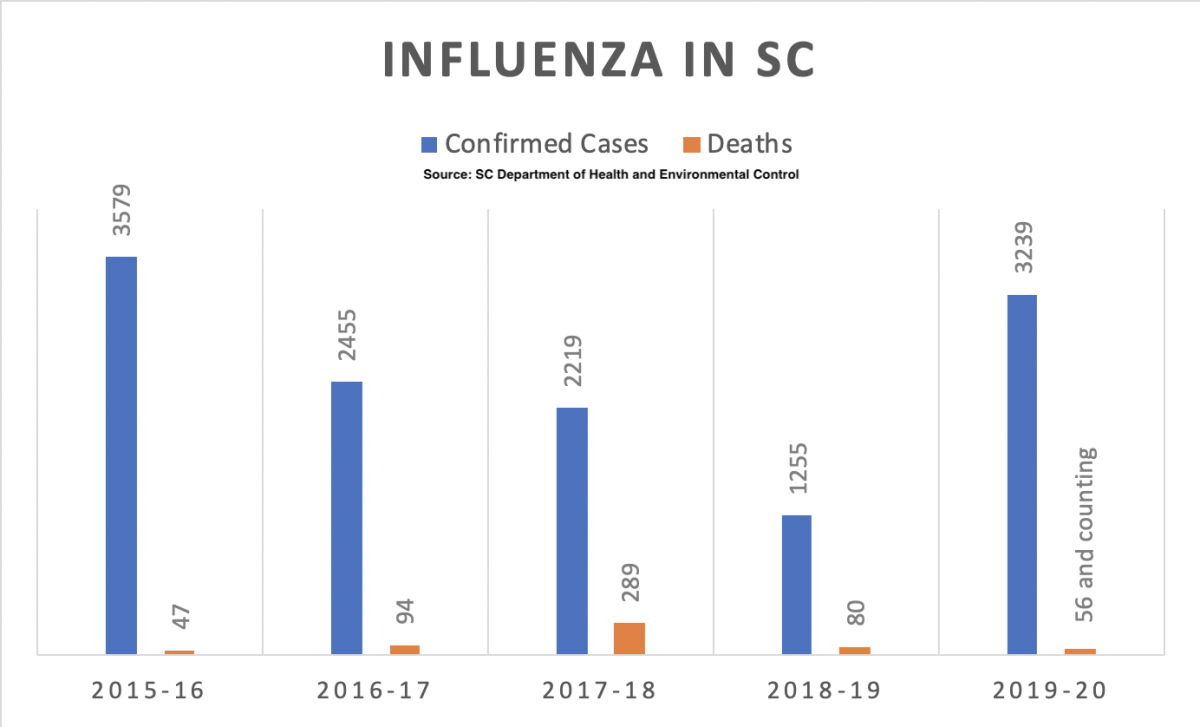This article was written by a student of ENGL 3330: Writing for the News Media, which is taught by Mike Pulley.
More than 1,660 influenza-associated hospitalizations and 56 deaths have been recorded in South Carolina. this flu season, according to the South Carolina Department of Health and Environmental Control (DHEC).
Rising cases make this flu season the most widespread that South Carolinians have seen in four years—3,239 lab-confirmed cases and counting, said DHEC. However, it has not proven to be one of the deadliest.
Despite these statistics, many people still choose not to receive a flu vaccine because of personal beliefs and misconceptions about the virus and the components of the vaccine.
“I chose not to get the flu shot because the last three years I received it, I still caught the flu,” Mia Tyler, a junior psychology major, said.
The vaccine is not always 100 percent effective because the strain is predicted a year in advance, Kit Hinkle, a Publix pharmacist said. This prediction is achieved based on patterns in other countries and from the active strain the previous year. However, if the strain is not accurately predicted, the vaccine will still lessen symptoms if you catch the flu.
Increasing numbers of people have grown concerned with the safety of the vaccine. Some have said it makes them sick while others say it is filled with hazardous ingredients.
“I don’t like shots at all, and in the past, I don’t get the flu when I don’t get the vaccination,” said Tyler.
For individuals that are apprehensive about shots, the nasal spray is available this year at Redfern and other doctors’ offices, yet not at pharmacies, according to Hinkle. The nasal spray differs from the injection because it is a weakened live virus, said Hinkle. This means that the strain is not inactivated or “killed” and could still trigger flu-like symptoms if the immune system is weakened. The shot, however, is inactivated and cannot cause infection.
The inclusion of formaldehyde in the vaccine has triggered the concern of most anti-vaccination advocates. But the amount of formaldehyde actually administered in the vaccine is a piece of crucial information many miss.
“The level of formaldehyde that remains in a vaccine (such as the flu vaccine) is much lower than the amount that occurs naturally in the human body,” said the Food and Drug Administration (FDA). The manufacturers responsible for the vaccines are held to very high standards to ensure safety.
“Some people I have met say that they have never had the flu before, and they do not see the importance of vaccination under these circumstances,” Hinkle said. “However, even if you have not had the flu before your body is still just as susceptible to the virus.”
Vaccination has statistically proven to be effective.
“During the 2016–2017 season, vaccination prevented an estimated 5.3 million illnesses, 2.6 million medical visits and 85,000 influenza-associated hospitalizations,” according to the Centers for Disease Control and Prevention (CDC).
Vaccinating does not only benefit the recipient but protects those around them, according to the CDC. When babies or the elderly contract influenza, it can lead to severe symptoms, hospitalization or even death. If more people get the vaccine, it decreases the likeliness of spreading the virus to more susceptible persons.
Insurance plans cover the cost of flu vaccines for 95% of enrollees, according to Hinkle. Some pharmacies, such as Publix, also offer $10 gift cards for those who get vaccinated there.
According to the CDC, viruses are spread by droplets and can spread from person to person up to six feet away through coughing, sneezing and even talking. Less frequently, it is spread through surfaces that have droplets when the recipient touches their nose or mouth after contact. To protect from the flu, frequent handwashing after contact with other people and shared surfaces is highly recommended.
Flu season lasts from October to May, and if you choose not to be vaccinated, practicing avid good hygiene is crucial. People who are vaccinated should do the same as well, but chances of contraction are lowered.








